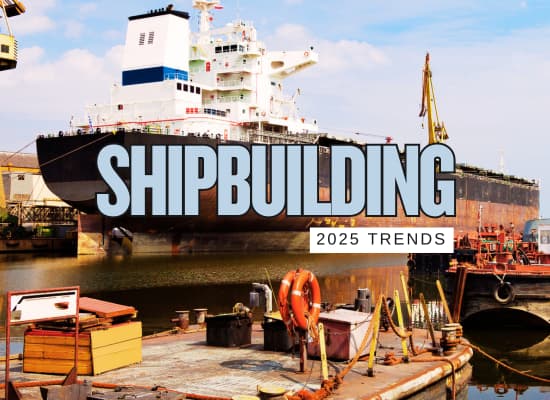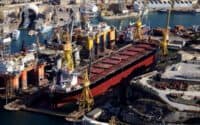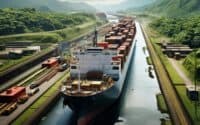Top 2025 Trends Shaping the Future of Shipbuilding

The shipbuilding world isn’t just evolving—it’s transforming. From carbon-neutral vessels to robotic welders and AI-powered design tools, the future of shipbuilding is being shaped by technology, sustainability demands, and global politics. Whether you're a shipowner, maritime engineer, or simply watching the industry closely, these 12 trends are more than buzzwords—they’re the blueprint for what's coming next.

We welcome your feedback, suggestions, corrections, and ideas for enhancements. Please click here to get in touch.
Shipyards around the world are rapidly evolving into high-tech hubs, leveraging digital tools to streamline operations, reduce costs, and boost efficiency. The push toward "smart shipyards" is one of the most important shifts in modern shipbuilding.
⚙️ Core Components:- Integrated Design Platforms that allow real-time collaboration and reduce design flaws.
- Automation and Robotics for welding, painting, and materials handling to improve precision and safety.
- IoT & Sensor Integration across construction equipment to enable live data tracking and predictive maintenance.
- Faster production timelines and streamlined workflows.
- Lower material waste and rework due to increased accuracy.
- Enhanced safety and quality control during all phases of construction.
- High initial investment in digital infrastructure and training.
- Integration with legacy systems can be complex.
- Cybersecurity risks due to increased digital exposure.
- Leading shipyards like Hyundai Heavy Industries and Damen Shipyards are partnering with tech firms to accelerate their transformation—watch their moves to stay ahead.
The maritime industry is increasingly turning to alternative fuels to reduce greenhouse gas emissions and comply with international environmental regulations. This shift is critical for achieving sustainability goals and mitigating the environmental impact of shipping operations.
🌱 Prominent Alternative Fuels:- Liquefied Natural Gas (LNG): Offers a reduction in CO₂ emissions compared to traditional marine fuels and is currently the most widely adopted alternative fuel in shipping.
- Ammonia: Considered a promising zero-carbon fuel, with several companies investing in ammonia-fueled vessel projects.
- Hydrogen: Provides a clean energy source with water as the only emission, though challenges remain regarding storage and infrastructure.
- Methanol: Gaining traction due to its compatibility with existing infrastructure and potential for carbon-neutral production.
- In 2024, orders for alternative-fueled ships increased by 50%, indicating a significant industry shift towards cleaner energy sources.
- Major shipping companies are investing in dual-fuel vessels capable of operating on both conventional and alternative fuels to facilitate the transition.
- High costs associated with developing new fuel technologies and retrofitting existing vessels.
- Limited availability of alternative fuels and the need for extensive bunkering infrastructure.
- Regulatory uncertainties and the need for standardized guidelines for alternative fuel usage.
- Collaboration among shipbuilders, fuel producers, and regulatory bodies is essential to accelerate the adoption of alternative fuels and achieve decarbonization targets.
Modular construction techniques are revolutionizing shipbuilding by enhancing efficiency, reducing costs, and allowing for greater customization. This approach involves building ships in pre-fabricated sections or modules, which are then assembled to form the complete vessel.
🛠️ Key Features:- Standardized Modules: Utilizing uniform components that can be easily assembled, modified, or replaced.
- Parallel Construction: Enables different modules to be constructed simultaneously, reducing overall build time.
- Flexibility: Allows for easy adaptation to different ship types and functionalities by rearranging or substituting modules.
- Shorter construction timelines due to concurrent module fabrication.
- Cost savings from mass production of standardized modules.
- Improved quality control as modules can be built in controlled environments.
- Enhanced ability to upgrade or repair specific sections without overhauling the entire vessel.
- Ensuring structural integrity and seamless integration of modules.
- Managing the complexity of coordinating multiple module construction processes.
- Initial investment in design and standardization processes.
- The Royal Danish Navy's StanFlex system exemplifies successful implementation of modular design, allowing for rapid role adaptation and efficient resource utilization.
Shipbuilding is embracing automation and robotics to enhance precision, reduce labor costs, and improve safety. These technologies are transforming traditional shipyard operations, leading to more efficient and consistent production processes.
🤖 Key Applications:- Robotic Welding Systems: Automated welding robots perform complex welds with high precision, reducing errors and increasing structural integrity.
- Automated Cutting Machines: CNC plasma and laser cutters provide accurate and rapid cutting of steel plates, minimizing material waste.
- Material Handling Robots: Autonomous guided vehicles (AGVs) transport heavy components within shipyards, enhancing safety and efficiency.
- Increased production speed and throughput.
- Enhanced worker safety by reducing exposure to hazardous tasks.
- Consistent quality and reduction in rework due to improved precision.
- High initial investment in robotic systems and infrastructure.
- Need for specialized training for staff to operate and maintain automated systems.
- Integration complexities with existing shipyard workflows.
- Leading shipyards are adopting collaborative robots (cobots) that work alongside human workers, combining human dexterity with robotic precision for optimal efficiency.
The maritime industry is progressing towards autonomous vessels capable of operating with minimal or no human intervention. These ships utilize advanced sensors, artificial intelligence, and control systems to navigate and perform tasks, potentially revolutionizing maritime operations.
🚢 Levels of Autonomy:- Degree One: Ships with automated processes and decision support, where seafarers are on board to operate and control systems.
- Degree Two: Remotely controlled ships with seafarers on board, operated from another location with crew available to take control if necessary.
- Degree Three: Remotely controlled ships without seafarers on board, fully operated from a remote location.
- Degree Four: Fully autonomous ships capable of making decisions and determining actions independently.
- Potential reduction in human error leading to increased safety.
- Operational cost savings by reducing crew-related expenses.
- Optimized fuel consumption through advanced route planning and navigation.
- Regulatory and legal frameworks need to evolve to accommodate autonomous operations.
- Cybersecurity concerns related to remote operation and data integrity.
- Public and industry acceptance of reduced human involvement in vessel operations.
- Collaborations between technology companies and maritime organizations are accelerating the development and testing of autonomous vessel prototypes, paving the way for broader adoption in the near future.
The incorporation of advanced materials in shipbuilding is revolutionizing vessel performance, durability, and environmental sustainability. By utilizing materials such as composites, aluminum alloys, and high-strength steels, shipbuilders can achieve significant improvements in various aspects of maritime engineering.
🔬 Key Advanced Materials:- Fiber-Reinforced Plastics (FRP): Lightweight and corrosion-resistant, FRP reduces overall vessel weight, leading to improved fuel efficiency and lower emissions.
- Aluminum Alloys: Known for their strength-to-weight ratio, aluminum alloys contribute to constructing lighter ships without compromising structural integrity.
- High-Strength Steels: These steels allow for thinner hull structures, reducing weight while maintaining robustness and safety standards.
- Enhanced fuel efficiency due to reduced vessel weight.
- Lower maintenance costs owing to superior corrosion resistance.
- Extended service life and improved structural performance.
- Higher initial material costs compared to traditional options.
- Need for specialized manufacturing techniques and workforce training.
- Ensuring compatibility with existing shipbuilding practices and regulations.
- Collaborative projects are underway to integrate lightweight materials into shipbuilding, aiming to enhance efficiency and sustainability in maritime operations.
Improving energy efficiency in ship design and operation is paramount for reducing fuel consumption and minimizing environmental impact. The International Maritime Organization (IMO) has introduced measures like the Energy Efficiency Design Index (EEDI) to promote energy-efficient ship designs.
⚙️ Key Strategies:- Optimized Hull Designs: Streamlined hull shapes reduce hydrodynamic resistance, leading to lower fuel consumption.
- Air Lubrication Systems: Creating a layer of air bubbles beneath the hull decreases friction between the ship and water, enhancing efficiency.
- Waste Heat Recovery Systems: Capturing and reusing waste heat from engines improves overall energy utilization.
- Reduced operational costs through lower fuel expenditures.
- Compliance with international environmental regulations and standards.
- Enhanced competitiveness in a market increasingly focused on sustainability.
- Significant upfront investment in energy-efficient technologies.
- Balancing efficiency improvements with cargo capacity and vessel performance.
- Keeping pace with evolving regulations and technological advancements.
- Implementing a Ship Energy Efficiency Management Plan (SEEMP) provides a structured approach to monitoring and enhancing a vessel's energy performance throughout its operational life.
To comply with stringent environmental regulations and reduce the maritime industry's carbon footprint, shipbuilders are integrating advanced emission control technologies into vessel designs. These technologies aim to minimize pollutants such as sulfur oxides (SOx), nitrogen oxides (NOx), and particulate matter emitted during ship operations.
🌊 Key Technologies:- Scrubber Systems: Devices installed in exhaust systems to remove SOx from engine emissions, allowing ships to meet sulfur emission standards while using high-sulfur fuels.
- Selective Catalytic Reduction (SCR): Technology that reduces NOx emissions by injecting a urea-based solution into the exhaust stream, converting NOx into harmless nitrogen and water.
- Exhaust Gas Recirculation (EGR): A method that recirculates a portion of exhaust gases back into the engine cylinders, lowering combustion temperatures and reducing NOx formation.
- Compliance with international emission regulations, such as those established by the International Maritime Organization (IMO).
- Improved air quality and reduced environmental impact in port and coastal areas.
- Potential for continued use of existing fuel types while meeting emission standards.
- High installation and maintenance costs associated with emission control systems.
- Space constraints on vessels for retrofitting necessary equipment.
- Ensuring the proper disposal of waste products generated by emission control processes.
- Shipowners and operators should conduct comprehensive cost-benefit analyses to determine the most suitable emission control strategies, considering factors such as operating regions, fuel availability, and vessel specifications.
As maritime operations become increasingly digitized, the industry faces growing cybersecurity threats targeting vessels, ports, and associated infrastructure. Implementing robust cybersecurity measures is essential to protect against unauthorized access, data breaches, and potential disruptions to maritime activities.
🔐 Key Measures:- Network Segmentation: Dividing onboard networks to isolate critical systems from non-essential ones, limiting the spread of potential cyber threats.
- Regular Software Updates: Ensuring that all systems and software are up-to-date with the latest security patches to protect against known vulnerabilities.
- Crew Training and Awareness: Educating personnel on cybersecurity best practices, including recognizing phishing attempts and proper use of onboard systems.
- Incident Response Planning: Developing and regularly testing response plans to effectively address and mitigate cyber incidents when they occur.
- Protection of sensitive data and critical maritime infrastructure.
- Reduced risk of operational disruptions caused by cyber incidents.
- Enhanced compliance with international cybersecurity regulations and standards.
- Keeping pace with the rapidly evolving cyber threat landscape.
- Integrating cybersecurity measures into legacy systems and existing vessels.
- Allocating sufficient resources and funding to implement comprehensive cybersecurity programs.
- Collaborating with cybersecurity experts and organizations can provide valuable insights and resources to strengthen maritime cybersecurity frameworks and resilience.
Emphasizing lifecycle sustainability in shipbuilding involves adopting practices that minimize environmental impact from design and construction through operation and eventual decommissioning. This holistic approach ensures that vessels are environmentally friendly throughout their entire lifespan.
🌱 Key Practices:- Eco-Friendly Design: Incorporating energy-efficient hull forms, propulsion systems, and materials that reduce emissions and fuel consumption.
- Use of Sustainable Materials: Selecting materials that are durable, recyclable, and sourced responsibly to lessen environmental impact.
- Efficient Manufacturing Processes: Implementing production techniques that reduce waste, energy consumption, and emissions during the construction phase.
- End-of-Life Recycling: Designing vessels with decommissioning in mind, ensuring materials can be recycled or disposed of responsibly at the end of their service life.
- Reduced environmental footprint throughout the vessel's lifecycle.
- Compliance with international environmental regulations and standards.
- Enhanced reputation and marketability for shipbuilders and operators committed to sustainability.
- Higher initial costs associated with sustainable materials and technologies.
- Need for industry-wide standards and certifications for sustainable practices.
- Balancing sustainability goals with economic and operational considerations.
- Collaborative initiatives between shipbuilders, regulatory bodies, and environmental organizations are essential to develop and promote sustainable practices across the maritime industry.
The growth of offshore renewable energy projects, particularly wind farms, has led to an increased demand for specialized vessels designed to install, maintain, and support these installations. These support vessels are critical to the efficient and safe development of offshore renewable energy infrastructure.
🚢 Key Types of Support Vessels:- Wind Turbine Installation Vessels (WTIVs): Equipped with heavy-lift cranes and dynamic positioning systems to transport and install wind turbine components at sea.
- Service Operation Vessels (SOVs): Provide accommodation and logistical support for maintenance crews working on offshore wind farms.
- Crew Transfer Vessels (CTVs): Facilitate the rapid transport of personnel and light equipment between shore bases and offshore installations.
- Offshore Substation Platforms: Serve as hubs for electrical collection and distribution from multiple turbines to the onshore grid.
- Enhanced efficiency and safety in the construction and maintenance of offshore renewable energy projects.
- Support for the global transition to sustainable energy sources by enabling large-scale offshore installations.
- Creation of new market opportunities for shipbuilders and maritime service providers specializing in renewable energy support.
- High capital investment required for the design and construction of specialized vessels.
- Need for crews with specialized training to operate and maintain advanced vessel systems.
- Regulatory and logistical complexities associated with operating in offshore environments.
- Shipbuilders and operators should engage with renewable energy developers early in project planning to ensure vessel designs meet specific operational requirements and timelines.
Geopolitical dynamics significantly impact the global shipbuilding industry, influencing trade policies, defense strategies, and international collaborations. Recent developments have underscored the importance of understanding these influences.
🌍 Key Influences:- Trade Policies and Tariffs: The imposition of tariffs and trade barriers affects the cost and flow of shipbuilding materials and components, altering competitive advantages among shipbuilding nations.
- National Security Considerations: Governments prioritize domestic shipbuilding capabilities to ensure naval defense readiness and reduce reliance on foreign-built vessels, leading to initiatives aimed at revitalizing national shipbuilding industries.
- International Alliances and Conflicts: Diplomatic relationships and regional tensions influence shipbuilding contracts, with countries favoring allies for defense-related shipbuilding projects and collaborations.
- Shifts in global shipbuilding dominance as nations implement policies to protect and promote their domestic industries.
- Potential restructuring of supply chains to navigate trade restrictions and ensure access to essential materials.
- Increased investment in technological innovation to maintain competitiveness amid changing geopolitical landscapes.
- Navigating complex international regulations and compliance requirements.
- Managing risks associated with geopolitical instability, such as sanctions or trade disputes.
- Balancing national interests with the benefits of global collaboration and open markets.
- Shipbuilders and stakeholders should closely monitor geopolitical developments and engage in strategic planning to mitigate risks and capitalize on emerging opportunities in the global market.
The shipbuilding industry is entering a defining era. Driven by the urgency of climate change, rapid digital transformation, evolving trade dynamics, and a push for long-term sustainability, the future of maritime construction will look nothing like its past. As each of these trends continues to mature, they’re not only reshaping how ships are built, but also redefining what it means to be competitive in global shipping.
From shipyards experimenting with AI and robotics to governments reshoring production in response to geopolitical shifts, shipbuilders must now think strategically across technology, policy, and environmental stewardship. Those who anticipate change, invest wisely, and collaborate across sectors will be best positioned to lead the next wave of maritime innovation. Whether you're a shipowner, investor, engineer, or policymaker, understanding these trends isn’t optional — it’s essential for navigating the seas ahead.
Table Summary
| ShipUniverse: Summary of Top 12 Shipbuilding Trends | ||
| Trend | Explanation | Importance |
| Digital Transformation and Smart Shipyards | Shipyards are going digital—think AI, IoT, sensors, and real-time data analytics all working together to make shipbuilding faster, cleaner, and cheaper. | Faster builds, fewer mistakes, and lower costs. Plus, it's easier to monitor and predict maintenance with real-time data. |
| Adoption of Alternative Fuels | From LNG to ammonia and even hydrogen, shipbuilders are designing vessels that can run on cleaner fuels instead of just heavy oil. | Helps meet global emission targets, reduces reliance on traditional bunker fuel, and gets ahead of future regulations. |
| Modular Ship Design and Construction | Ships are built in Lego-like blocks (modules) in different spots, then assembled together—way quicker and more customizable. | Speeds up construction, makes upgrades easier, and reduces downtime during repairs or refits. |
| Integration of Automation and Robotics | Welding robots, automated cutters, and even robotic transporters are now doing the heavy lifting (literally) in shipyards. | Boosts precision, cuts down labor costs, and keeps workers out of hazardous zones. |
| Development of Autonomous Vessels | Ships are being built with tech that can navigate, avoid collisions, and make real-time decisions without humans at the helm. | Could lead to safer, cheaper operations—especially for cargo vessels on long-haul routes. |
| Use of Advanced Materials | Think high-strength steel, aluminum alloys, and composite materials replacing traditional stuff to make ships lighter and tougher. | Better fuel economy, less corrosion, and longer-lasting hulls. That’s money saved over time. |
| Emphasis on Energy Efficiency | Everything from sleek hull designs to air lubrication systems and waste heat recovery tech is being added to ships to cut down energy use. | Lower fuel bills, fewer emissions, and better compliance with global environmental standards. It’s a win-win-win. |
| Implementation of Emission Control Technologies | Ships are getting scrubbers, selective catalytic reduction (SCR) systems, and exhaust gas recirculation (EGR) to clean up emissions before they hit the air. | Keeps ships compliant with IMO regulations and helps improve air quality—especially near coasts and ports. |
| Enhanced Cybersecurity Measures | More tech means more risk. Shipbuilders are now baking in network segmentation, encrypted comms, and staff training to defend against hacks. | Prevents major disruptions, protects cargo and sensitive data, and keeps critical onboard systems safe from cyber threats. |
| Focus on Lifecycle Sustainability | Ship design is shifting to consider the entire lifespan—from build to scrap. Think recyclable materials, clean power, and smart decommissioning plans. | Cuts environmental impact, future-proofs ships, and aligns with ESG goals. It’s also increasingly favored by regulators and investors. |
| Expansion of Offshore Renewable Energy Support Vessels | As offshore wind and tidal projects grow, shipbuilders are creating vessels specifically for installing turbines, servicing equipment, and moving crews. | Supports the booming clean energy market and gives shipyards a new stream of specialized, high-value projects. |
| Geopolitical Influences on Shipbuilding | Trade tensions, military priorities, and economic nationalism are reshaping where ships get built and who gets the contracts. | Governments are boosting domestic shipbuilding to reduce reliance on foreign yards—creating both risks and opportunities depending on where you operate. |

Do you have a Maritime Product or Service that may be of interest to Shipowners? Tell us about it here!
Do you have feedback or insights? Please reach out to editor @ shipuniverse.com



